Survey of the Agricultural Tenant Farmers
Survey of all agricultural tenants in Scotland
2 TENANT FARMERS AND THE LAND THEY FARM
Summary
1. Almost three-quarters (74%) of respondents were over 50 years old. Fewer than one in ten (7%) was under 40.
2. Half of the respondents said that they or their family had farmed their main tenancy for over 50 years. One in ten respondents had farmed their main tenancy for fewer than ten years.
3. The main reasons respondents gave for renting-in land were that: they wanted to stay on their family farm; were content to stay on a tenanted farm; or that they could not afford to buy land.
4. The majority of tenant farming businesses in Scotland farm one holding. A third of tenant farming businesses leased all of their business under a Secure 1991 Tenancy, while a similar proportion leased up to a quarter of their business under this type of tenancy.
Characteristics of Tenant Farmers
2.1 Around nine out of ten respondents who participated in the survey were male and one out of ten female (88% and 12% respectively), a similar split to the population of farm occupiers in general[3].
2.2 Three quarters were aged over 50 years (74%), with a third aged over 65 years (33%). One in five (19%) respondents were in the 40-49 age group, while fewer than one in ten were aged under 40 years (7%). These results are shown in Figure 2.1 below, and reflect the population of farm occupiers in general[4].
Figure 2.1: Age of respondents
Q. What age group are you in?
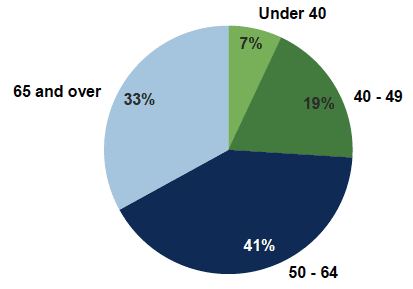
Base: All respondents who gave an answer (3,028)
Source: Ipsos MORI
2.3 It was found that respondents who were aged over 70 years were more likely to farm Livestock (LFA sheep or cattle) under 80 hectares and 'Other' type farms (25% and 29% compared to 20% overall). Respondents in the North West were more likely to be aged over 70 years (27% compared to 20% overall).
2.4 Seventeen per cent of respondents had a long term illness, disability or health problem (including problems due to old age) which limits the daily activities or work that they can do. Of this group, almost all were aged over 50 years (95%), with six in ten aged over 65 years (62%). This compares with 19% in the general working-age population[5]. Given the previously mentioned age profile of respondents, this will reflect the fact that farmers need to be active.
2.5 Respondents were asked how long they or their family had farmed on their main tenancy (Figure 2.2). Half of respondents said that they or their families had farmed their main tenancy for over 50 years (50%), while around a quarter said they or their families had farmed it for 25 to 49 years (23%). A quarter of respondents said that they or their family had been farming on their main tenancy for less than 25 years (15% between 10-24 years, and 10% for 0 to 9 years).
Figure 2.2: Length of time farming on main tenancy
Q. How long have you or your family farmed on your main tenancy?
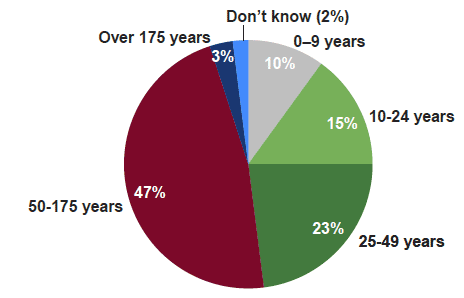
Base: All respondents who gave an answer (2,933)
Source: Ipsos MORI
Land farmed by Tenant Farmers
2.6 Respondents were asked about the number, size and nature of the holdings that they farm. The majority of respondents farm one holding (71%), 17% farm two holdings, and 12% farm three or more (Figure 2.3).
Figure 2.3: Number of holdings farmed
Q. How many holdings do you farm?
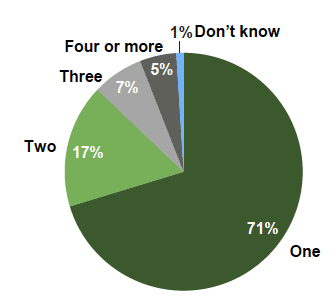
Base: All respondents who gave an answer (3,010)
Source: Ipsos MORI
Table 2.1: Number of holdings farmed by region, farm type and business size
| Number of holdings farmed (excluding don't knows) | Base | ||||
|---|---|---|---|---|---|
| One | Two | Three | Four or more | ||
| % | % | % | % | ||
| Region | |||||
| North East | 69 | 17 | 9 | 5 | 629 |
| North West | 76 | 15 | 6 | 3 | 710 |
| South East | 67 | 21 | 7 | 5 | 732 |
| South West | 71 | 17 | 7 | 5 | 897 |
| Farm type | |||||
| Arable | 64 | 21 | 9 | 6 | 390 |
| Livestock (LFA cattle and sheep) over 80 hectares | 67 | 21 | 8 | 5 | 798 |
| Livestock (LFA cattle and sheep) under 80 hectares | 77 | 14 | 5 | 4 | 644 |
| Mixed | 69 | 18 | 9 | 4 | 360 |
| Non-LFA cattle and sheep | 71 | 16 | 7 | 5 | 308 |
| Other | 74 | 15 | 7 | 5 | 468 |
| Farm business size[6] | |||||
| Up to 80 hectares | 86 | 11 | 3 | 1 | 461 |
| 81 to 400 hectares | 67 | 22 | 7 | 4 | 922 |
| 401 to 2,000 hectares | 66 | 16 | 10 | 8 | 612 |
| 2,001 hectares and over | 69 | 18 | 8 | 5 | 833 |
| Overall | 71 | 17 | 7 | 5 | 2968 |
2.7 Table 2.1 shows the number of holdings farmed by region, farm type and farm business size. Those who held Arable farms and those who occupied Livestock (LFA sheep or cattle over 80 hectares) were more likely than average to farm more than one holding (36%, 34% respectively compared to 29% overall), while those who occupied Livestock (LFA sheep or cattle) under 80 hectares farms were more likely to farm just one holding (77% compared to 71% overall). Those in the North West were more likely to have one holding (76% compared to 71% overall) while those in the South East were most likely to have more than one holding (33% compared to 29% overall). Unsurprisingly, smaller farms are more likely to be comprised of a single holding.
2.8 As shown in Figure 2.4, the majority of respondents reported that they had one landlord for leases of more than one year (69%) with 11% having two landlords and 3% having three or more. Sixteen per cent of respondents reported that they had no landlords for leases of more than one year. These respondents are most likely to farm using seasonal lets.
Figure 2.4: Number of landlords
Q. How many different landlords do you have for leases of more than 1 year?
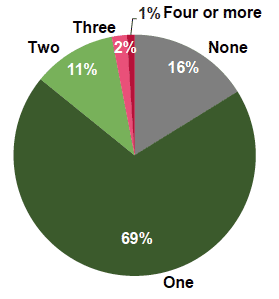
Base: All respondents who gave an answer (3,006)
Source: Ipsos MORI
2.9 Respondents in the North East were more likely to have two or more landlords for leases of more than one year, as were those who farmed Livestock (LFA cattle and sheep) over 80 hectares type farms (19% and 20% respectively, compared to 15% overall).
2.10 Respondents were asked about the size of their holdings, as well as how long they had been held by the respondent or their family and whether or not they were Secure 1991 tenancies.
2.11 From the information on holding size, it is possible to estimate the proportion of tenant farms holding any land under these arrangements. However, this is not straightforward and there is some uncertainly around these results. This relates to how blank responses are interpreted. For the individual components a blank response is normally assumed to mean that no land is held in this way as respondents tend to assume that a blank will be interpreted as a zero.
2.12 Treating blank responses as representing no holdings, the proportions of respondents who farm these types of tenure are as follows:
- 80% reported renting some farm land on a lease of 1 year of more. (Among this group, 31% also reported renting-in some land as a seasonal let, and 36% reported also holding land that they own and farm).
- 37% gave a figure for an amount of land that they own and farm themselves.
- 30% reported renting-in land as a seasonal let.
- 5% gave a figure for owning land and renting it out as a seasonal let
- 2% gave a figure for owning land and renting it out on a lease of one year or more.
2.13 However, overall, 9% of respondents did not give figures to any of the hectarage questions. This could be because they did not know, preferred not to say, or for some other unknown reason. If these cases are excluded from the analysis, the proportion renting farm land on a lease of 1 year or more increases to 88%, those owning land that they farm themselves to 41% and those renting in as a seasonal let to 33%.
2.14 The total size of holdings can be estimated by summing the size of the various types of holding. Again, there is some uncertainty in these estimates due to the 9% who did not report a hectarage on any of these types of holding.
2.15 Excluding respondents who did not report any hectarage, the median size of a business holding overall was found to be 390 hectares. The largest 20% of holdings farmed over 6,566 hectares, while the smallest 20% of holdings farmed fewer than 90 hectares.
2.16 A summary of the median values of hectarage by type of arrangement is shown in Figure 2.5. The average holding size of land rented-in on a lease of 1 year or more was 240 hectares for those that held this type of land, while the average hectarage of land owned and farmed was 202 hectares. The average size of land rented-in as a seasonal let was 89 hectares.
Figure 2.5: Median size of different types of land category within the farm business
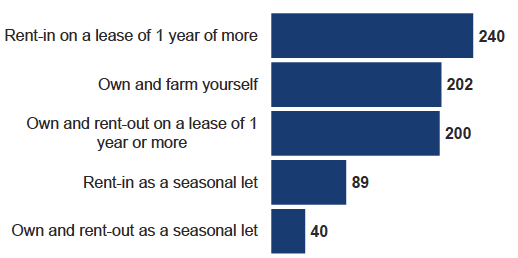
Base: All respondents who gave an answer (2,467; 916; 1,156; 61; 156)
Source: Ipsos MORI
2.17 Respondents were asked how many Secure 1991 tenancies they rented-in. As shown in Figure 2.6, around a quarter (26%) said that they did not hold any Secure 1991 tenancies, 61% rented-in one Secure 1991 tenancy, with 10% renting-in two or more.
Figure 2.6: Number of Secure 1991 Tenancies
Q. How many Secure 1991 Tenancies do you rent-in?
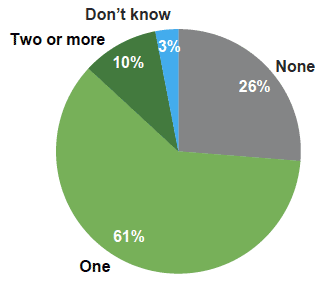
Base: All respondents who gave an answer (2,969)
Source: Ipsos MORI
2.18 As shown in Table 2.2, those who rented-in no Secure 1991 tenancies were more likely to be aged under 50 years of age (33% compared to 26% overall).
Table 2.2: Number of Secure 1991 Tenancies by age group
| Age | ||||
|---|---|---|---|---|
| Under 40 | 40 to 49 | 50 to 64 | 65 and over | |
| % | % | % | % | |
| None | 38 | 31 | 25 | 22 |
| One | 48 | 54 | 64 | 61 |
| Two | 4 | 8 | 8 | 8 |
| Three or more | 2 | 3 | 2 | 5 |
| Base | 214 | 567 | 1,278 | 893 |
2.19 Livestock (LFA cattle and sheep) over 80 hectares type farmers were more likely than other types of farmers to farm just one Secure 1991 tenancy (67% compared to 60% overall), while Mixed farmers were more likely to farm two or more Secure 1991 tenancies (17% compared to 10% overall). Farmers in the North East were more likely than other regions to farm at least one Secure 1991 tenancy (78% compared to 70% overall).
2.20 Respondents were asked to record the proportion of their business that was leased-in under a Secure 1991 tenancy. Almost a third (31%) of respondents leased all of their business under a Secure 1991 tenancy, with half (50%) leasing over 50% of their land under a Secure 1991 tenancy. Around a third (30%) rented less than a quarter of their business under a Secure 1991 tenancy. The overall results are shown in Figure 2.7.
Figure 2.7: Proportion of land leased-in under Secure 1991 Tenancies
Q. Roughly what proportion of your business is leased under a Secure 1991 Tenancy?
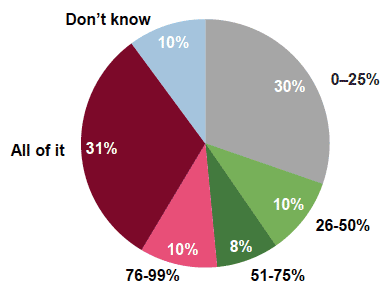
Base: All respondents who gave an answer (2,815)
Source: Ipsos MORI
2.21 Respondents who leased less than a quarter of their business under a Secure 1991 tenancy were more likely to be aged under 40 years (42% compared to 30% overall). Meanwhile, those who leased all of their business under a Secure 1991 tenancy were more likely to be aged over 65 years (39% compared to 31% overall).
2.22 Table 2.3 shows the proportion of businesses rented under Secure 1991 tenancies by farm size, type and broad geography. Livestock (LFA cattle and sheep) over 80 hectares and Mixed type farms were most likely to lease more than half of their business under a Secure 1991 tenancy (69% and 58% respectively compared to 55% overall). Further, those who leased 76% or more of their business under a Secure 1991 tenancy were more likely to farm holdings of farm type Livestock (LFA cattle and sheep) over 80 hectares than the other types of farm (54% compared to 42% overall). There was less variation by region and farm size.
Table 2.3: Proportion of business leased under a Secure 1991 Tenancy by region, farm type and business size
| Proportion of business leased under a Secure 1991 Tenancy (excluding don't know responses) | Base | |||||
|---|---|---|---|---|---|---|
| 0-25% | 26-50% | 51-75% | 76-99% | All of it | ||
| % | % | % | % | % | ||
| Region | ||||||
| North East | 29 | 13 | 12 | 10 | 35 | 508 |
| North West | 34 | 10 | 6 | 8 | 41 | 605 |
| South East | 37 | 10 | 9 | 13 | 31 | 609 |
| South West | 33 | 11 | 9 | 13 | 33 | 765 |
| Farm type | ||||||
| Arable | 38 | 11 | 9 | 12 | 29 | 329 |
| Livestock (LFA cattle and sheep) over 80 hectares | 19 | 12 | 12 | 18 | 39 | 568 |
| Livestock (LFA cattle and sheep) under 80 hectares | 44 | 10 | 6 | 5 | 35 | 498 |
| Mixed | 32 | 10 | 14 | 14 | 30 | 298 |
| Non-LFA cattle and sheep | 37 | 13 | 9 | 11 | 30 | 253 |
| Other | 36 | 10 | 6 | 9 | 40 | 539 |
| Farm business size[7] | ||||||
| Up to 80 hectares | 34 | 6 | 7 | 7 | 46 | 346 |
| 81 to 400 hectares | 34 | 13 | 10 | 12 | 31 | 836 |
| 401 to 2,000 hectares | 37 | 11 | 7 | 12 | 32 | 533 |
| 2,001 hectares and over | 31 | 11 | 10 | 13 | 35 | 748 |
| Overall | 34 | 11 | 9 | 11 | 35 | 2512 |
2.23 To understand why tenant farmers choose to rent-in land, respondents were presented with a series of statements and asked to what extent they agreed or disagreed with each. The results present a mixed picture of motivations.
Figure 2.8: Main reasons for renting-in land
Q. How much do you agree of disagree with these statements on why you rent-in land?
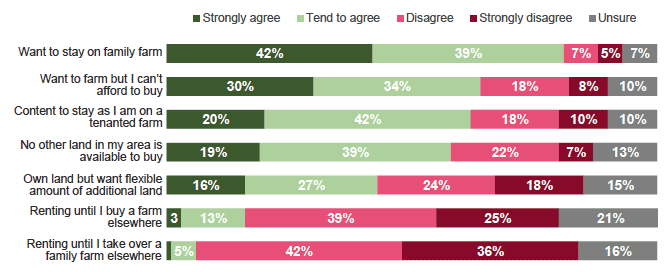
Base: All respondents who gave an answer (2,554; 2,496; 2,602; 2,452; 2,446; 2,366; 2,341)
Source: Ipsos MORI
2.24 The statement that most respondents agreed with, in relation to why they rent-in land, was "Want to stay on our family farm" (81%). Two-thirds of respondents agreed that they "Want to farm but I can't afford to buy" (64%), while a similar proportion agreed with the statement "Content to stay as I am on a tenanted farm" (62%). Overall results are shown in Figure 2.8.
2.25 Respondents who had been farming their main tenancy for less than ten years were more likely to strongly agree with the statement "Want to farm but I can't afford to buy" (43% compared to 30% overall). Further, this group were more likely to disagree with the statement "Content to stay as I am on a tenanted farm" (37% compared to 28% overall).
Contact
Email: Angela Morgan
There is a problem
Thanks for your feedback